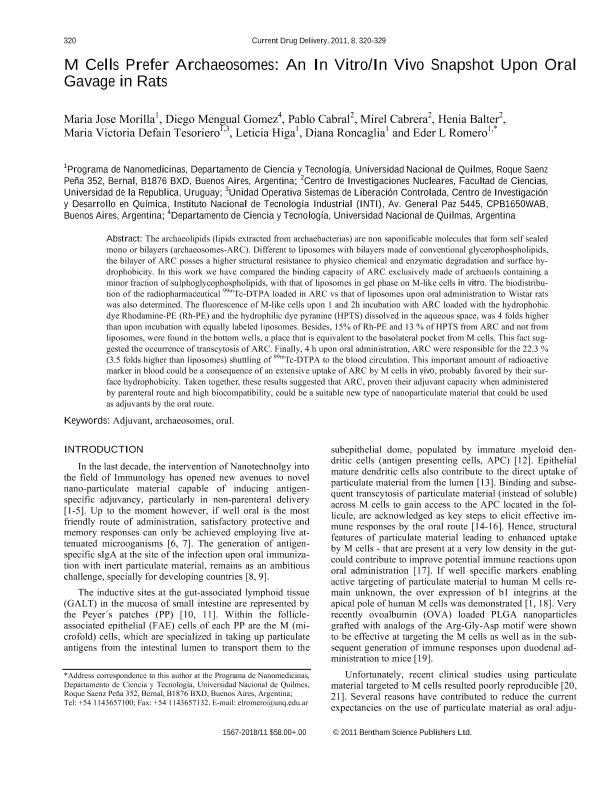Mostrar el registro sencillo del ítem
dc.contributor.author
Morilla, María José

dc.contributor.author
Mengual Gómez, Diego Luis

dc.contributor.author
Cabral, Pablo
dc.contributor.author
Cabrera, Mirel
dc.contributor.author
Balter, Henia
dc.contributor.author
Defain Tesoriero, María Victoria

dc.contributor.author
Higa, Leticia Herminia

dc.contributor.author
Roncaglia, Diana Inés

dc.contributor.author
Romero, Eder Lilia

dc.date.available
2023-03-27T18:42:54Z
dc.date.issued
2011-01
dc.identifier.citation
Morilla, María José; Mengual Gómez, Diego Luis; Cabral, Pablo; Cabrera, Mirel; Balter, Henia; et al.; M cells prefer archaeosomes: An in vitro/in vivo snapshot upon oral gavage in rats; Bentham Science Publishers; Current Drug Delivery; 8; 3; 1-2011; 320-329
dc.identifier.issn
1567-2018
dc.identifier.uri
http://hdl.handle.net/11336/191718
dc.description.abstract
The archaeolipids (lipids extracted from archaebacterias) are non saponificable molecules that form self sealed mono or bilayers (archaeosomes-ARC). Different to liposomes with bilayers made of conventional glycerophospholipids, the bilayer of ARC posses a higher structural resistance to physico chemical and enzymatic degradation and surface hydrophobicity. In this work we have compared the binding capacity of ARC exclusively made of archaeols containing a minor fraction of sulphoglycophospholipids, with that of liposomes in gel phase on M-like cells in vitro. The biodistribution of the radiopharmaceutical 99mTc-DTPA loaded in ARC vs that of liposomes upon oral administration to Wistar rats was also determined. The fluorescence of M-like cells upon 1 and 2h incubation with ARC loaded with the hydrophobic dye Rhodamine-PE (Rh-PE) and the hydrophilic dye pyranine (HPTS) dissolved in the aqueous space, was 4 folds higher than upon incubation with equally labeled liposomes. Besides, 15% of Rh-PE and 13 % of HPTS from ARC and not from liposomes, were found in the bottom wells, a place that is equivalent to the basolateral pocket from M cells. This fact suggested the occurrence of transcytosis of ARC. Finally, 4 h upon oral administration, ARC were responsible for the 22.3 % (3.5 folds higher than liposomes) shuttling of 99mTc-DTPA to the blood circulation. This important amount of radioactive marker in blood could be a consequence of an extensive uptake of ARC by M cells in vivo, probably favored by their surface hydrophobicity. Taken together, these results suggested that ARC, proven their adjuvant capacity when administered by parenteral route and high biocompatibility, could be a suitable new type of nanoparticulate material that could be used as adjuvants by the oral route.
dc.format
application/pdf
dc.language.iso
eng
dc.publisher
Bentham Science Publishers

dc.rights
info:eu-repo/semantics/openAccess
dc.rights.uri
https://creativecommons.org/licenses/by/2.5/ar/
dc.subject
ADJUVANT
dc.subject
ARCHAEOSOMES
dc.subject
ORAL
dc.subject.classification
Otras Nanotecnología

dc.subject.classification
Nanotecnología

dc.subject.classification
INGENIERÍAS Y TECNOLOGÍAS

dc.title
M cells prefer archaeosomes: An in vitro/in vivo snapshot upon oral gavage in rats
dc.type
info:eu-repo/semantics/article
dc.type
info:ar-repo/semantics/artículo
dc.type
info:eu-repo/semantics/publishedVersion
dc.date.updated
2023-03-23T12:25:24Z
dc.journal.volume
8
dc.journal.number
3
dc.journal.pagination
320-329
dc.journal.pais
Estados Unidos

dc.journal.ciudad
San Francisco
dc.description.fil
Fil: Morilla, María José. Consejo Nacional de Investigaciones Científicas y Técnicas; Argentina. Universidad Nacional de Quilmes. Departamento de Ciencia y Tecnología; Argentina
dc.description.fil
Fil: Mengual Gómez, Diego Luis. Consejo Nacional de Investigaciones Científicas y Técnicas; Argentina. Universidad Nacional de Quilmes. Departamento de Ciencia y Tecnología; Argentina
dc.description.fil
Fil: Cabral, Pablo. Universidad de la República; Uruguay
dc.description.fil
Fil: Cabrera, Mirel. Universidad de la República; Uruguay
dc.description.fil
Fil: Balter, Henia. Universidad de la República; Uruguay
dc.description.fil
Fil: Defain Tesoriero, María Victoria. Universidad Nacional de Quilmes. Departamento de Ciencia y Tecnología; Argentina. Instituto Nacional de Tecnología Industrial; Argentina
dc.description.fil
Fil: Higa, Leticia Herminia. Consejo Nacional de Investigaciones Científicas y Técnicas; Argentina. Universidad Nacional de Quilmes. Departamento de Ciencia y Tecnología; Argentina
dc.description.fil
Fil: Roncaglia, Diana Inés. Universidad Nacional de Quilmes. Departamento de Ciencia y Tecnología; Argentina
dc.description.fil
Fil: Romero, Eder Lilia. Consejo Nacional de Investigaciones Científicas y Técnicas; Argentina. Universidad Nacional de Quilmes. Departamento de Ciencia y Tecnología; Argentina
dc.journal.title
Current Drug Delivery
dc.relation.alternativeid
info:eu-repo/semantics/altIdentifier/url/https://www.eurekaselect.com/article/18712
dc.relation.alternativeid
info:eu-repo/semantics/altIdentifier/doi/http://dx.doi.org/10.2174/156720111795256138
Archivos asociados
